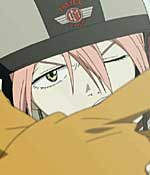
by Owen Thomas
Kazuya Tsurumaki was a relatively little-known animator when Hideki Anno selected him to work as the assistant director on Neon Genesis Evangelion. For the TV series, which became a smash hit in Japan and one of the touchstones of the current surge of interest in anime in the US, Tsuramaki served as the main storyboard artist as well as assistant director, and when Studio Gainax began production on a trio of Evangelion films Tsurumaki got his first directorial assignment. As he tells the story, Anno came to him after Eva and announced that he was out of ideas and that it was up to Tsurumaki to dream up the next project because, "you are next." Tsurumaki let his imagination run wild, but by the time he had written a script, Anno - despite his declaration that he had no stories left to tell - was already several steps ahead of Tsurumaki and in pre-production for his next series, Kareshi Kanojo no Jijo, leaving Tsurumaki a chance to have complete and unsupervised creative control of his own series FLCL. FLCL, referred to as "Fooly Cooly" (or "Furikuri" by its American fans), is unlike any anime series to come before it. Wild, maniacally fast-paced physical comedy; exaggerated, exuberant animation alternately pushing towards surrealist- as when mecha exuviate from a bump on young Naota's head - and deconstructionist - as when the animation literally stops and the story is told by a camera bouncing across a page of black and white manga art panels; and obsessively, often irrelevantly, referential to obscure Tokyo-pop bands and anime insider trivia; FLCL was hyperkinetic and disorienting, yet mesmerizing, almost transgressive, and undeniably original. It inspired enthusiastic admiration for Tsurumaki as a creator, even amongst the perhaps 90% of the series' fans who were absolutely baffled by much of it. One is tempted to refer to it as announcing the arrival of full blown post-modernism in animation, or perhaps as the Exploding Plastic Inevitable of the anime industry. When Tsurumaki visited Baltimore to speak to American fans at the recent Otokon Convention, predictably, many of the questions were along the lines of, "Hi, I really loved FLCL [or Evangelion], but could you please explain this part of it to me?" Tsurumaki answered all questions genially with a self-deprecating and often mischievous sense of humor. For example:
Why does Haruko hit Naota over the head with her guitar? Kazuya Tsurumaki: Naota is trying to be a normal adult and she belts him to make him rethink his decision.
Why does Evangelion end violently, and somewhat unhappily? KT: People are accustomed to sweet, contrived, happy endings. We wanted to broaden the genre, and show people an ugly, unhappy ending.
Why is the character of Shinji portrayed as he is? KT: Shinji was modeled on director Hideki Anno. Shinji was summoned by his father to ride a robot, Anno was summoned by Gainax to direct an animation. Working on Nadia [Nadia: Secret of the Blue Water, one of Anno and Tsurumaki's earlier projects] he wondered if he still wanted to work like this. He thought that working on Eva could help him to change.
Is there any particular reason why so many Gainax series feature very anxious, unhappy young male protagonists with no parents? KT: Yes, the directors at Gainax are all basically weak, insecure, bitter, young men. So are many anime fans. Many Japanese families, including my own, have workaholic fathers whose kids never get to see them. That may influence the shows I create.
|


